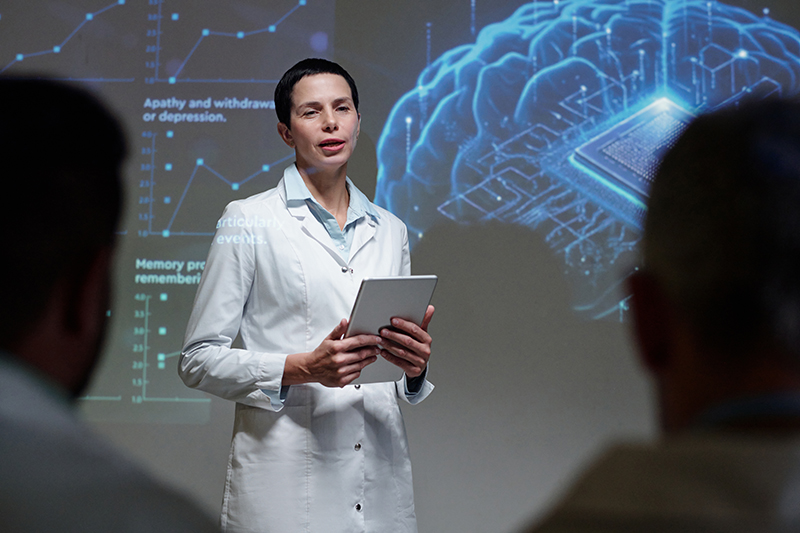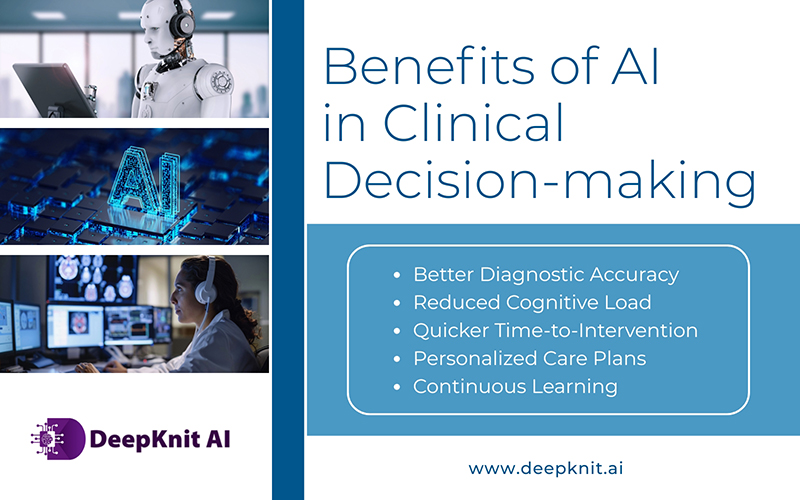The recent technological advancements have been revolutionizing the healthcare industry and the introduction of AI in clinical decision support has significantly improved clinician’s decisions and patient outcomes.
Did you know that implementing AI-driven clinical decision support systems (CDSS) in hospitals helped reduce diagnostic errors by 21%? To put it into perspective, it can catch a life-threatening disease much earlier than usual—which could be a life-saving moment.
In this post, we will explore how AI is revolutionizing CDS by enhancing accuracy and efficiency, thereby imparting better patient outcomes. We’ll also touch on how DeepKnit AI is helping healthcare organizations achieve the objective of experiencing AI’s power in decision support in clinical settings.
What Is Clinical Decision Support (CDS)?
Clinical Decision Support (CDS) refers to implements that provide clinicians with intelligently curated, evidence-based information at the right times to support critical decision-making. Traditionally, CDS provides details like:
- Alerts and Reminders: Notifications regarding drug–drug interactions, allergy warnings, or reminders for preventive care (e.g. flu vaccinations).
- Order Sets and Protocols: Systematized templates for monitoring and appropriately handling specific conditions.
- Guideline-based Recommendations: Integrating best-practice clinical guidelines into workflows (for example, sepsis management protocols).
Even though these tools have mitigated errors and variability, they are dependent on static rules, manual configuration, and limited data sources. This is where AI steps into the limelight.
How AI Is Revolutionizing Patient Care
How AI Improves Clinical Decision Support
- Data Integration and Interoperability
AI-driven CDS platforms can take in and standardize information from numerous disparate sources like EHRs, radiology PACS, wearable devices, etc. Natural Language Processing (NLP) algorithms help process disorganized clinical notes and extract vital info (e.g. symptoms, diagnoses, medications). Machine Learning (ML) can then reconcile these with the organized fields, leading to a unified patient profile that is regularly updated.
- Predictive Analytics and Risk Hierarchy
Predictive analytics in healthcare has the capability to regularly evaluate patients’ risk of developing health issues such as sepsis, acute kidney injury, or readmission—often hours or days before clinical signs become overt, even before a clinician does. These AI models leverage data, combining vitals, lab trends, and historical patterns to trigger the alert.
- Sepsis Prediction: A deep learning model goes through hundreds of features (heart rate variability, lactate levels, white blood cell count) simultaneously to detect early sepsis indicators.
- Readmission Risk: By analyzing comorbidities, social factors, and medication adherence patterns, AI can identify patients who may bounce back to the hospital, prompting targeted discharge planning.
- Natural Language Processing for Clinical Insights
Huge volumes of valuable information thrive in free-text clinical documentation viz, dictated notes, discharge summaries, and even patient emails. NLP algorithms can:
- Extract key findings (e.g. “localized chest pain radiating to the left arm”)
- Identify sentiment or context (e.g. social stressors affecting health)
- Summarize lengthy reports into concise, actionable insights
This means a physician does not have to sift through pages of progress notes to figure out that a patient’s spouse recently became ill, which is an important social determinant that might impact discharge planning.
- Custom Treatment Recommendations
AI-driven precision medicine comprises genomic data, proteomic profiles, and patient-specific variables (age, allergies etc.) to recommend personalized treatment plans. For oncology patients, for instance, an AI CDS might:
- Sequence a tumor’s genetic mutations
- Match those mutations to relevant therapies
- Flag required clinical trials for which the patient is eligible.
By contrast, traditional CDS might only remind a clinician of a general chemotherapy protocol based on tumor type, without deeper molecular insights.
Real-world Applications of AI in CDS
- Radiology and Imaging Interpretation
Radiologists are inundated with imaging studies like CTs, MRIs, X-rays. AI-powered image analysis tools can:
- Detect subtle fractures or lung nodules that might be missed on initial read
- Triage critical findings (e.g. intracranial hemorrhage) to ensure rapid review
- Quantify tumor volume changes over time, aiding in therapy response assessment.
A leading medical center reported that integrating an AI module into its radiology workflow cut average time-to-diagnosis by nearly 50% for stroke patients, significantly improving door-to-needle times.
- Pathology and Digital Slides
Digital pathology slides can go beyond 1 GB in size. AI algorithms help in:
- Finding out malignant regions in tissue biopsies
- Grading prostate cancer by analyzing glandular architecture
- Predicting treatment response based on cell morphology.
Institutions using AI-assisted pathology were found to have the pathologist workload drop by 30%, enabling them to handle complex case reviews.
- Early Warning Systems in Intensive Care Units (ICUs)
In the ICU, time is everything. AI-driven vital-sign monitoring systems continuously learn patient-specific baselines and can alert staff to subtle deviations. For instance, a gradual increase in respiratory rate and heart rate over several hours might predict respiratory failure before oxygen saturation drops. Intervening early can mean the difference between a successful extubation and prolonged mechanical ventilation.
Benefits of AI in Clinical Decision-making
-
- Better Diagnostic Accuracy: AI can detect patterns imperceptible to humans, reducing missed diagnoses.
- Reduced Cognitive Load: By filtering out noise and only surfacing clinically relevant alerts, AI mitigates alert fatigue.
- Quicker Time-to-Intervention: Predictive analytics catch deterioration early, translating to quicker interventions.
- Personalized Care Plans: Instead of one-size-fits-all guidelines, patients receive recommendations tailored to their unique profiles.
- Continuous Learning: AI models can be retrained on new data, ensuring that the CDS system evolves alongside medical knowledge.
Limitations and Challenges
Despite all the promise, AI in CDS is not immune to challenges. Here are a few obstacles one will have to deal with:
- Data Quality and Bias
If the underlying data is incomplete or biased, chances of AI predictions to be flawed are high. For instance, an AI model trained predominantly on adult patients may not produce the desired results while working for pediatric populations.
- Explainability and Trust
Many advanced AI models (e.g. deep neural networks) operate as “black boxes.” And therefore, clinicians hesitate to trust a prediction if they cannot understand the underlying reasoning. Explainable AI (XAI) is working towards tackling this issue by providing feature-attribution maps, but transparency is still a work in progress.
- Integration Complexity
Embedding AI modules into existing EHR workflows is technically challenging. Clinicians don’t want to toggle between multiple screens; seamless, context-sensitive integration is the key.
- Regulatory and Compliance Hurdles
AI systems used for diagnosis/treatment recommendations may be subject to regulatory approval (e.g. FDA clearance in the United States). Navigating these takes time, resources, and diligent validation.
- Data Privacy and Security
Patient data is sensitive. AI platforms therefore must employ robust encryption and strict access controls. Ideally, data governance policies should align with HIPAA (in the U.S.) or equivalent regulations in other countries.
- Maintaining the Human Touch
AI should augment and not replace the clinician–patient relationship in the evolving landscape of artificial intelligence in healthcare. Personalized recommendations must never trump the importance of empathy, active listening, and patient preferences, only a human can give. Clinicians should remain the ultimate arbiters of care decisions.
The Future of AI in Clinical Decision Support
The future landscape of AI in healthcare and real-time AI support in ICUs is bright, with several exciting developments on the horizon:
- Integrated Learning and Collaborative Models
Rather than collating raw patient data into a central repository, federated learning allows models to be trained at each institution. Only the updated model weights are shared, safeguarding patient privacy. This approach facilitates the creation of robust, generalizable AI tools without exposing sensitive data.
- Real-time Genomic Integration
As whole-genome sequencing becomes faster and more affordable, we’ll witness AI-powered CDS systems that incorporate genomic risk profiles in real time; even before a patient visits the clinic.
- Voice-assisted Clinical Support
Imagine “smart” exam rooms where clinicians can ask voice-activated AI agents for relevant guidelines (For e.g.: “What’s the latest sepsis protocol for an 8-year-old?”) while having conversation with the patient in real time.
- Augmented Reality (AR) in Surgery and Bedside Care
AR tech could assist surgeons by highlighting anatomical structures or displaying AI-annotated radiology findings directly on the patient. Similarly, bedside nurses could use AR glasses to view AI-generated vital sign trends, in real time without having to refer to a note or another device.
- Continuous Learning Health Systems
Ultimately, AI will enable a “learning health system” where every encounter feeds new insights back into the AI pipeline. Treatment outcomes, bad events, and even patient satisfaction scores will refine future recommendations.
Learn more in this detailed post:
Limitations of AI in Medical Decision Making
Why Partner with DeepKnit AI for Advanced Healthcare Solutions?
Throughout our discussion, you’ve probably understood how AI can dramatically improve clinical decision-making. However, building, validating, and maintaining these systems is a complex endeavor. And that’s where DeepKnit AI stands out:
- Proven Expertise in Healthcare AI
DeepKnit AI has collaborated with leading academic-medical facilities in integrating our predictive CDS tools that has helped minimize ICU mortality and lengths of stay.
- End-to-End Solutions
From data upload and model development, to seamless EHR integration and ongoing performance monitoring, DeepKnit AI offers a turnkey platform. We take care of complex tasks, so your clinicians can focus on patient care.
- Compliance and Security
DeepKnit AI adheres to the highest standards: HIPAA, GDPR, and ISO 27001. Our federated-learning capabilities further ensure patient data doesn’t leave your firewall without proper de-identification.
- Customization
Whether you’re a small community hospital or a large healthcare organization, we tailor our solutions to align with your infrastructure, clinician workflows, and specific patient populations.
Conclusion
AI has grown into a transformative force that is fast reshaping clinical decision support from static, rule-based reminders to dynamic, predictive, and personalized recommendations. By seamlessly integrating raw data sources, utilizing predictive analytics, and integrating advanced AI tech, it can augment clinician expertise, reduce diagnostic errors, and most importantly, improve patient outcomes.
However, realizing AI’s full potential requires a partner who understands the technology and appreciates the niche dynamics of healthcare delivery. DeepKnit AI offers end-to-end AI solutions that prioritize accuracy, trust, and patient-centric care.
If you’re ready to elevate your clinical decision support capabilities, consider collaborating with us to bring next-generation AI healthcare solutions to your organization.
Transform Your Care Delivery
Save lives using our revolutionary predictive CDS!
Try Now


